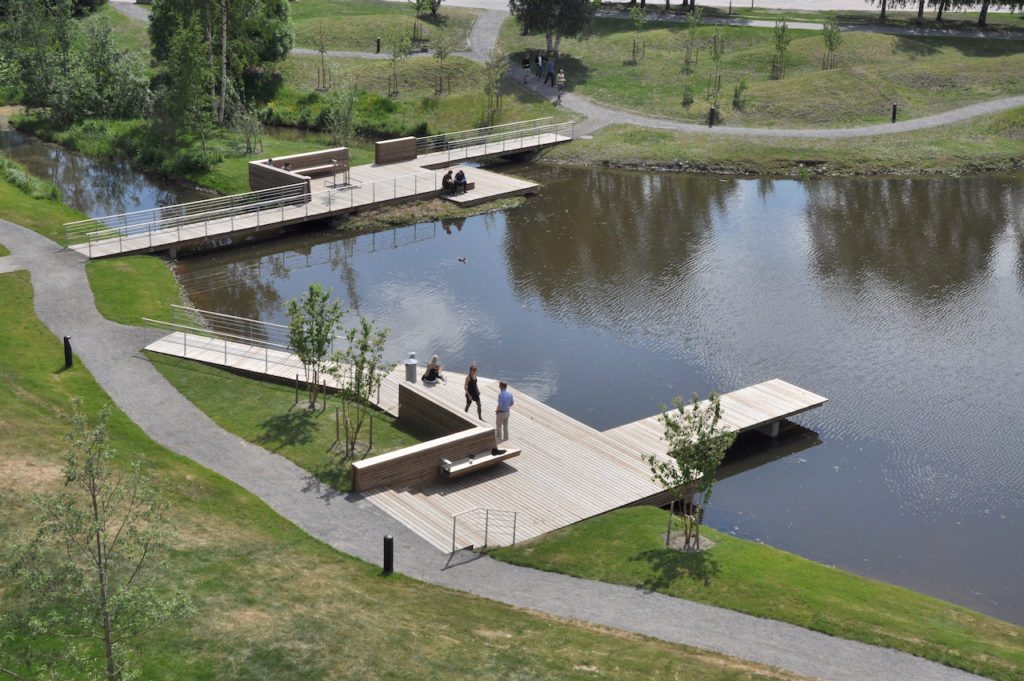
Architect
Sweco Architects
Thorbjörn Andersson
Type of Area
Pond
Land/water interaction
Pier
Bridges
Terraces/steps
Built Environment Types
Highly built
Low green
Scale of Impact
Place
Block
District/neighbourhood
Intervention Scale (Spatial)
Moderate site
Project Types
Public space regeneration
Urban design
Outdoor recreation
Urban/ Rural
Inner urban area
Visibility and Openness
Fully enclosed
Fully contained view
Learning in the landscape
Umeå University, in Sweden, is located on the Gulf of Bothnia coast, approximately 300 km south of the Artic Circle. The aim of the park was to offer an attractive space that enhanced the university environment. The park provides a non-hierarchical space outside of the formal learning areas of lecture theatres and laboratories where informal discussions and the exchange of ideas can take place.
There is adequate space in the campus park for socialising, reading and relaxing on the lawned areas, the sunbathing places and jetties, fulfilling the mandate of the design to close the gap between nature and work. The many walking and cycle trails connect the different parts of the campus. A plaza connects the park to the University library and includes picnic tables and benches. The sloping lawns and terraces provide an open view of the lake
In the 1960s the stream flowing through the university’s grounds was dammed to create a pear-shaped lake, around which the original buildings were grouped, inspired by a similar design at the University of Aarhus in Denmark. This artificial lake, set in a hilly landscape, forms the centrepiece of the re-designed park area. Bridges link a deck on the small island within the lake to the shoreline.
The riprap edging allows people to get close to the water and the modular furniture and wooden decking lend a modern and open feel to the park. There is a combination of sunny and shaded areas dotted with birch trees. The walkways, constructed from gravel, are well-lit and wind around points of interest of various scales, some are quiet more intimate spots and some larger and livelier areas. Although the pathways are generally open, one section has a canyon-like effect over a small brook that trickles out from the lake. This area is covered by dense vegetation, creating a different atmosphere to the more open areas.
Perception and Meaning
Imageability
Legibility
Focal point
Place attachment
Health and Wellbeing
Place affordance
Increases socialisation
Restorativeness
Interaction with Water
Visual
Tactile – touching
Accessibility within the park is good, with wide well-lit pathways that make the park feel secure. The pond in the middle brings a focus for contemplation into the middle of a busy campus. Plenty of seating provides opportunity for outdoor areas where discussions can take place or just convivial meeting areas. The design rates highly for quality although it requires a fair amount of maintenance. The site is somewhat exposed to wind and sun but this will improve as the trees mature. The health and well-being aspects are adequate but being within the campus surrounded by the university buildings limits the sense of being away or contact with nature. It is a safe and secure environment.
The clean modern lines of the constructions around the pond area fit well with the modern atmosphere of the university. They are of good design with sustainable materials and easy to maintain. They also provide places for students and staff to get close to the water. The ramps also allow pushchairs and wheelchair access onto the decking areas.
Although the mixture of trees and open areas provide space for sitting at different times of the year, there is little space for water sports, which is understandable as it is designed as a space to meet, think and talk, not a space for play.
